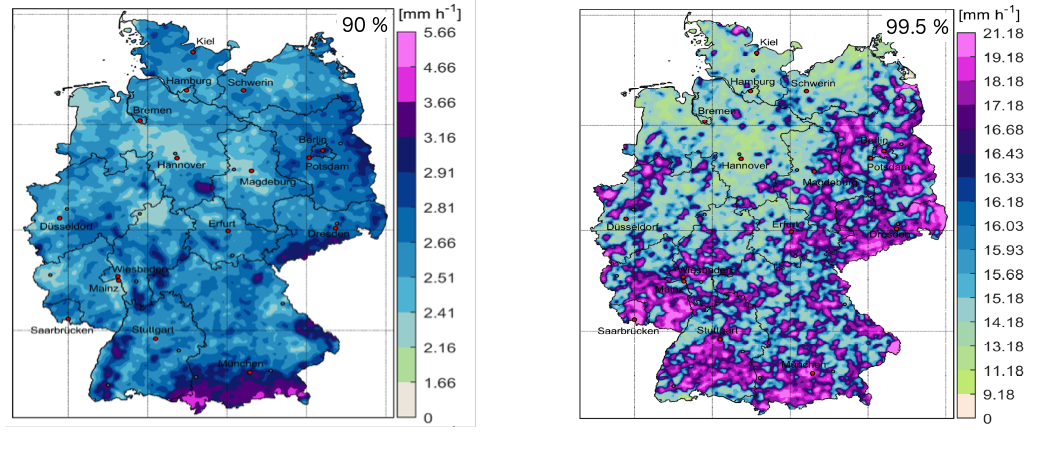Convective precipitation in urban areas
In most regions of Germany, the frequency and intensity of extreme precipitation events has increased in recent years. In urban regions in particular, this can lead to severe damage to infrastructures such as sewage treatment plants and overloading of sewer systems. This leads to a significant increase in flooding and thus to more damage to buildings and infrastructure and massive pollution of fresh water. Since a further increase of such extremes is to be expected in the future, suitable adaptation strategies have to be developed. In the sub-project „Urban flash floods and sewerage” within the Helmholtz Climate Initiative "Adaptation and Mitigation" (HI-CAM), the entire process chain from extreme precipitation scenarios, the serial occurrence of convective heavy rainfall events and floods to the resulting damage to infrastructures and the consequences for water quality is investigated.
Studies show that frequently occurring convective precipitation (≤ 90 % percentile) in Germany is markedly shaped by topography (e.g., Abt, 2018). In the Alps and low mountain ranges, precipitation totals are significantly higher than in coastal regions, for example (Fig. 1). In contrast, rare or extreme convective precipitation is almost equally distributed in Germany. For this reason, the analyses are first carried out for the example region of Dresden. The aim is to subsequently transfer the knowledge gained there to the whole of Germany. For the current climate (2001 – 2019), the frequency and intensity of convective events will be statistically investigated on the basis of RADOLAN data from the German Weather Service (DWD). To estimate possible changes of convective precipitation totals under future climate conditions, an ensemble of 88 high-resolution regional climate models with different scenarios (1.5 °C, 2 °C, 3 °C) is analyzed. The period from 1971 to 2001 is chosen as the reference period.

Fig. 1: 90% (left) and 99.5% percentile of total precipitation (≥ 0.1 mm/h) based on RADOLAN data from the German Weather Service (2001 – 2018; Abt, 2018).
- The higher or more extreme the precipitation the greater the projected change.
- The higher the global temperature increase, the more uniform the change trends.
Fig. 2. shows an example of the projected change in mean precipitation [mm/d] in Dresden for one ensemble member (GCM: IPSL-CM5A-MR_rcp85_r1i1p1; RCM: WRF). The change in area mean is 0.4 (+1.5 K), 0.7 (+2 K), and 1.3 (+3 K). For rarer events (90th percentile), these changes are 1.7 (+1.5 K), 3.3 (+2 K), and 5.2 (+3 K). For even rarer events (99th percentile), the change is 2.8 (+1.5 K), 9.9 (+2.0 K), and 16.4 (+3 K).

Fig. 2: Example of precipitation change under future climate conditions for an ensemble member (forcing: IPSL-CM5A-MR; rcp85; r1i1p1; RCM: WRF). Left: +1.5 K (mean 0.31 mm/d), middle: +2 K (mean 0.32), right: +3 K (mean 0.43 mm/d; source: Melanie Karremann; KIT, IMK-TRO).
Further analysis shows a serial clustering of convective events for both the present and future. Piper et al. (2016) and Mohr et al. (2020) identified a correlation between serial clustering of heavy precipitation events and atmospheric blocking. Additionally, teleconnection pattern could play also a significant role (Piper et al., 2019). A possible change in large-scale atmospheric conditions under future climate conditions based on climate model data will now be analyzed in the next step.
References
Abt, R. (2018): Raumzeitliche Variabilität von konvektiven Starkniederschlägen in Deutschland. Bachelorarbeit am Institut für Meteorologie und Klimaforschung (IMK-TRO), Karlsruher Institut für Technologie (KIT), Karlsruhe, Deutschland.
Mohr, S., Wilhelm, J., Wandel, J., Kunz, M., Portmann, R., Punge, H. J., Schmidberger, Quinting, J. F., M., Grams, C. (2020): The role of large-scale dynamics in an exceptional sequence of severe thunderstorms in Europe May/June 2018. Weather Clim. Dynam., 1, 325–348, doi:10.5194/wcd-1-325-2020.
Piper D., M. Kunz, F. Ehmele, S. Mohr, B. Mühr, A. Kron, J. Daniell (2016): Exceptional sequence of severe thunderstorms and related flash floods in May and June 2016 in Germany. Part I: Meteorological background Nat. Hazards Earth Syst. Sci., 16, 2835–2850, doi:10.5194/nhess-16-2835-2016.
Piper, D., Kunz, M., Allen, J. T., Mohr, S. (2019): Investigation of the temporal variability of thunderstorms in Central and Western Europe and the relation to large-scale flow and teleconnection patterns. Q. J. R. Meteor. Soc., 145, 3644–3666, doi:10.1002/qj.3647.
